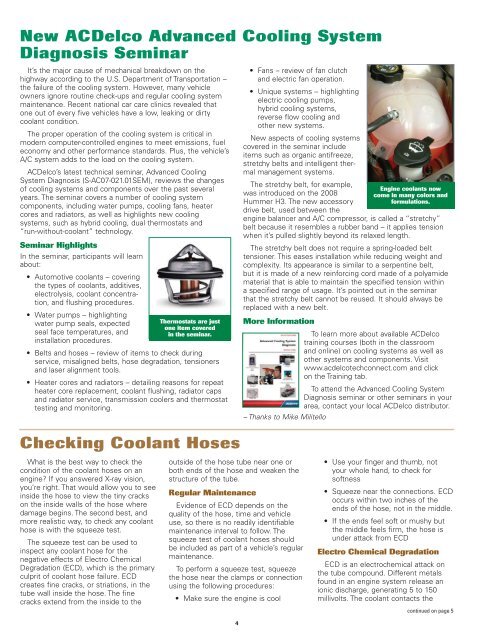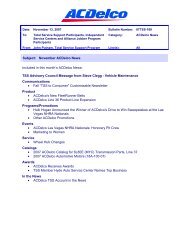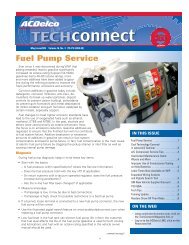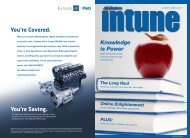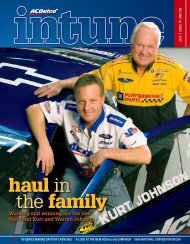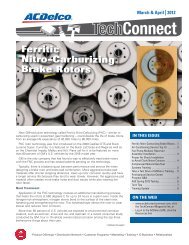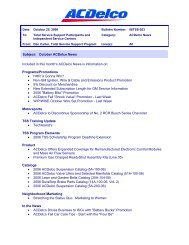Programming Tips and Tools - ACDelco TechConnect
Programming Tips and Tools - ACDelco TechConnect
Programming Tips and Tools - ACDelco TechConnect
You also want an ePaper? Increase the reach of your titles
YUMPU automatically turns print PDFs into web optimized ePapers that Google loves.
New <strong>ACDelco</strong> Advanced Cooling System<br />
Diagnosis Seminar<br />
It’s the major cause of mechanical breakdown on the<br />
highway according to the U.S. Department of Transportation –<br />
the failure of the cooling system. However, many vehicle<br />
owners ignore routine check-ups <strong>and</strong> regular cooling system<br />
maintenance. Recent national car care clinics revealed that<br />
one out of every five vehicles have a low, leaking or dirty<br />
coolant condition.<br />
The proper operation of the cooling system is critical in<br />
modern computer-controlled engines to meet emissions, fuel<br />
economy <strong>and</strong> other performance st<strong>and</strong>ards. Plus, the vehicle’s<br />
A/C system adds to the load on the cooling system.<br />
<strong>ACDelco</strong>’s latest technical seminar, Advanced Cooling<br />
System Diagnosis (S-AC07-021.01SEM), reviews the changes<br />
of cooling systems <strong>and</strong> components over the past several<br />
years. The seminar covers a number of cooling system<br />
components, including water pumps, cooling fans, heater<br />
cores <strong>and</strong> radiators, as well as highlights new cooling<br />
systems, such as hybrid cooling, dual thermostats <strong>and</strong><br />
“run-without-coolant” technology.<br />
Seminar Highlights<br />
In the seminar, participants will learn<br />
about:<br />
Automotive coolants – covering<br />
the types of coolants, additives,<br />
electrolysis, coolant concentration,<br />
<strong>and</strong> flushing procedures.<br />
Water pumps – highlighting<br />
water pump seals, expected<br />
seal face temperatures, <strong>and</strong><br />
installation procedures.<br />
Thermostats are just<br />
one item covered<br />
in the seminar.<br />
Belts <strong>and</strong> hoses – review of items to check during<br />
service, misaligned belts, hose degradation, tensioners<br />
<strong>and</strong> laser alignment tools.<br />
Heater cores <strong>and</strong> radiators – detailing reasons for repeat<br />
heater core replacement, coolant flushing, radiator caps<br />
<strong>and</strong> radiator service, transmission coolers <strong>and</strong> thermostat<br />
testing <strong>and</strong> monitoring.<br />
Checking Coolant Hoses<br />
What is the best way to check the<br />
condition of the coolant hoses on an<br />
engine? If you answered X-ray vision,<br />
you’re right. That would allow you to see<br />
inside the hose to view the tiny cracks<br />
on the inside walls of the hose where<br />
damage begins. The second best, <strong>and</strong><br />
more realistic way, to check any coolant<br />
hose is with the squeeze test.<br />
The squeeze test can be used to<br />
inspect any coolant hose for the<br />
negative effects of Electro Chemical<br />
Degradation (ECD), which is the primary<br />
culprit of coolant hose failure. ECD<br />
creates fine cracks, or striations, in the<br />
tube wall inside the hose. The fine<br />
cracks extend from the inside to the<br />
4<br />
Fans – review of fan clutch<br />
<strong>and</strong> electric fan operation.<br />
Unique systems – highlighting<br />
electric cooling pumps,<br />
hybrid cooling systems,<br />
reverse flow cooling <strong>and</strong><br />
other new systems.<br />
New aspects of cooling systems<br />
covered in the seminar include<br />
items such as organic antifreeze,<br />
stretchy belts <strong>and</strong> intelligent thermal<br />
management systems.<br />
The stretchy belt, for example,<br />
was introduced on the 2008<br />
Hummer H3. The new accessory<br />
drive belt, used between the<br />
outside of the hose tube near one or<br />
both ends of the hose <strong>and</strong> weaken the<br />
structure of the tube.<br />
Regular Maintenance<br />
Evidence of ECD depends on the<br />
quality of the hose, time <strong>and</strong> vehicle<br />
use, so there is no readily identifiable<br />
maintenance interval to follow. The<br />
squeeze test of coolant hoses should<br />
be included as part of a vehicle’s regular<br />
maintenance.<br />
To perform a squeeze test, squeeze<br />
the hose near the clamps or connection<br />
using the following procedures:<br />
Make sure the engine is cool<br />
Engine coolants now<br />
come in many colors <strong>and</strong><br />
formulations.<br />
engine balancer <strong>and</strong> A/C compressor, is called a “stretchy”<br />
belt because it resembles a rubber b<strong>and</strong> – it applies tension<br />
when it’s pulled slightly beyond its relaxed length.<br />
The stretchy belt does not require a spring-loaded belt<br />
tensioner. This eases installation while reducing weight <strong>and</strong><br />
complexity. Its appearance is similar to a serpentine belt,<br />
but it is made of a new reinforcing cord made of a polyamide<br />
material that is able to maintain the specified tension within<br />
a specified range of usage. It’s pointed out in the seminar<br />
that the stretchy belt cannot be reused. It should always be<br />
replaced with a new belt.<br />
More Information<br />
To learn more about available <strong>ACDelco</strong><br />
training courses (both in the classroom<br />
<strong>and</strong> online) on cooling systems as well as<br />
other systems <strong>and</strong> components. Visit<br />
www.acdelcotechconnect.com <strong>and</strong> click<br />
on the Training tab.<br />
To attend the Advanced Cooling System<br />
Diagnosis seminar or other seminars in your<br />
area, contact your local <strong>ACDelco</strong> distributor.<br />
– Thanks to Mike Militello<br />
Use your finger <strong>and</strong> thumb, not<br />
your whole h<strong>and</strong>, to check for<br />
softness<br />
Squeeze near the connections. ECD<br />
occurs within two inches of the<br />
ends of the hose, not in the middle.<br />
If the ends feel soft or mushy but<br />
the middle feels firm, the hose is<br />
under attack from ECD<br />
Electro Chemical Degradation<br />
ECD is an electrochemical attack on<br />
the tube compound. Different metals<br />
found in an engine system release an<br />
ionic discharge, generating 5 to 150<br />
millivolts. The coolant contacts the<br />
continued on page 5


